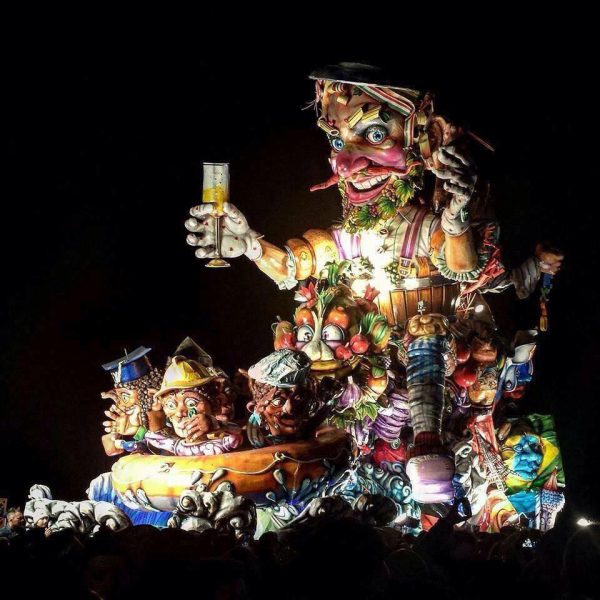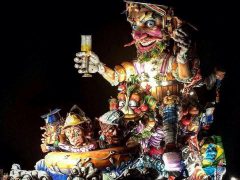Carnival of Sciacca
The first to speak of it was, in 1889, Giuseppe Pitre who mentioned it in his work Library of Sicilian popular traditions.
But the origins of the carnival of Sciacca, a city in the province of Agrigento, date back to a much older period, perhaps to the Roman era, when saturnalia was celebrated and their king was sacrificed; or rather, more likely, in 1616 when the viceroy of Sicily Pedro Téllez-Girón, III Duke of Osuna, established that on the last day of celebration everyone had to dress in masks. There is an ongoing rivalry with the Acireale carnival.
The first events are remembered as a popular festival, in which sausages, cannoli and a lot of wine were consumed; and the people poured into the streets, disguised in various ways. Subsequently, the first best decorated floats were paraded, carrying the masked people on chairs around the narrow streets of the city.
In the XNUMXs a large decorated platform appears, dragged by oxen or horses, which brought groups in masks. They acted in the local dialect, followed by small improvised orchestras. The stew, the sausages and the wine distributed already represented a moment of meeting and exchange between fellow villagers.
After the war the wagons were named, and began to make clear reference to the novelties of progress. Streamers and confetti began to be launched from the moving floats, creating a festive atmosphere, which enticed the participants to become the real protagonists of a collective joy. After a few more years, the delirious crowd gave rise to the first magazine companies, also being set up increasingly sophisticated allegorical floats that referred to local themes and characters in a satirical key.
With the experimentation of sound amplification, the Sciacca carnival evolved even more and floats were set up with ever larger figures and whose movements became more and more sophisticated. Local political satire left more room for characters known to a wider audience, or represented topical issues concerning national interests.
I allegorical wagons and the mini-floats, which are followed by the related masked groups, are conceived, designed and built in the months preceding the party, involving numerous locals from the very first preparations.
Thursday night is reserved for the last assemblies: the floats are placed in parade order along the road of the first city itinerary and are assembled on site. People taken by curiosity follow the progress of the work and get confused between the comings and goings of vehicles and personnel taken by the frenzy to finish the work to be sure that everything in the wagon works properly. In fact, even if designed and built in the previous months, the various "pieces" are assembled only on the street and just the night before the show starts. In fact, some tankers have had to modify the tank several times at the very last moment due to final assembly problems, running the risk of not participating.
On the day of the start of the parades, two routes are followed in the historic center of Sciacca. The parades took place on Saturday (first journey), Sunday, Monday and Tuesday (second journey) of the week preceding the start of the Lent.
Currently the Carnival begins on Shrove Thursday with the symbolic delivery of the keys of the city to the king of Carnival Pepe Nappa, a character adapted by the Saccensi as a local mask that opens and closes the party. The departure of the procession of chariots, with the chariot of Pepe Nappa out of the race, takes place from Piazza Friscia.
From that moment on, Peppe Nappa's chariot, parading through the streets of the city, begins to distribute wine and sausages prepared on the grill for the duration of the carnival, until the last evening of Shrove Tuesday, accompanied under the famous notes of musical hymn, is given to the stake (burned) in the square accompanied by pyrotechnic games.
Each year the allegorical floats are prepared by the individual associations which also lend themselves and commit themselves to the realization of the scripts (theme and history of each allegorical float) and to the creation and organization of lively musical hymns and ballets with groups of children and more; competing and competing with each other, but at the same time parading and making an entire city dance and move, each of the various floats with its masked groups, on the evening of Shrove Tuesday, after having presented and exhibited for all the other previous evenings on stage scene in Piazza Angelo Scandaliato and filmed live on local TV and radio Monte Kronio and from Sciacca television station, are classified according to various criteria (structure, movement, musical hymn, script, etc.) and only one will be judged the winner of the edition.
Since the 2011 edition, instead of wine, orange juice has been distributed to combat the phenomenon of alcoholism.
The contribution made by the Art Institute of Sciacca to the local carnival - for texts, music, ballets, models, representations, movements and choreographies - allowed it to compete successfully at national and world level with many other similar exhibitions.
Text source: Wikipedia
----------------
Technical sheet prepared by: Region of Sicily - Department of cultural heritage and Sicilian identity - CRicd: Regional center for inventory, cataloging and documentation and Sicilian regional film library
Web card insertion: Ignazio Caloggero
Photo: By EndrexSoft - Own work, CC BY-SA 4.0, https://commons.wikimedia.org/w/index.php?curid=47116946
Information contributions: Ignazio Caloggero / Web
Note: The populating of the files of the Heritage database proceeds in incremental phases: cataloging, georeferencing, insertion of information and images. The cultural property in question has been cataloged, georeferenced and the first information entered. In order to enrich the information content, further contributions are welcome, if you wish you can contribute through our area "Your Contributions"





